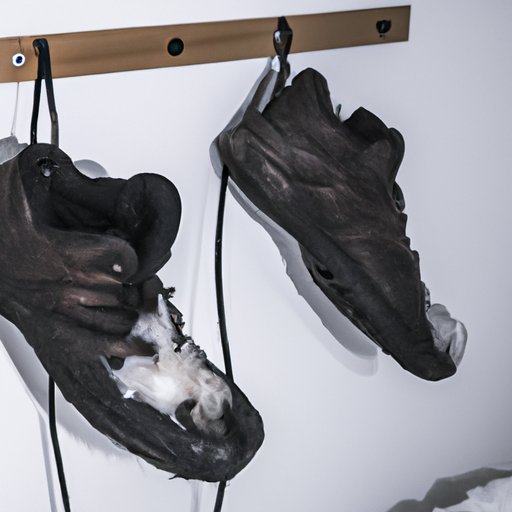
I. Introduction
Wet or damp shoes can be a common problem that causes discomfort and inconvenience. Whether it’s from rain, snow, or sweaty feet, having to wear damp shoes can be unpleasant. That’s why we’ve put together this guide to provide some helpful tips and tricks for drying shoes effectively.
II. Air it Out: The Best Way to Dry Shoes Naturally
The best way to dry shoes is to let them air-dry naturally. This method can help avoid damage from heat and minimize odors. To dry your shoes naturally, place them in a well-ventilated area with good air circulation. You can stuff them with newspaper or place them in front of a fan to speed up the process. Just make sure to switch out the wet newspaper with fresh, dry newspaper every hour or so until the shoes are completely dry.
III. Quick Tricks: How to Dry Shoes in a Hurry
If you’re in a hurry and need your shoes to dry quickly, there are several methods you can try. One option is to use a hairdryer on a low or cool setting and hold it a few inches away from the shoes. Another trick is to put your shoes in a bag with rice or silica gel packets for a few hours. If you have a little more time and money to invest, you can purchase a specialized shoe drying tool that uses gentle heat and airflow to dry your shoes fast.
IV. Dealing with Wet Shoes: How to Dry Them Without Damaging Them
If your shoes got soaking wet and you’re worried about damaging them during the drying process, there are ways to avoid this. First, remove the insoles from your shoes and let them dry separately so they don’t distort or lose their shape. Next, use absorbent fabrics like towels or paper towels to soak up any excess moisture. Finally, avoid direct heat sources like radiators or hairdryers, as these can damage some materials like leather or synthetic fabrics.
V. Winter Woes: How to Dry Snow or Rain-Soaked Shoes
Drying shoes that are wet from snow or rain can be even more challenging, especially during the colder months. One option is to use a boot dryer, which blows warm air into your shoes to speed up the drying process. You can also place your shoes near a heat source like a radiator or heater, or stuff them with crumpled paper to absorb any moisture. Just make sure to avoid leaving them on a surface that could be damaged by any remaining moisture.

VI. Creative Solutions: Unique Strategies for Drying Your Shoes
If you’re feeling adventurous, there are some fun and unexpected methods for drying shoes that can be effective. For example, you can hang your shoes on a clothesline outside in the sun, use a vacuum cleaner to suck out any moisture, or turn them upside down on an air conditioner that blows cool air. Just make sure to use common sense and avoid any techniques that could damage your shoes.
VII. Drying Techniques for Different Shoe Fabrics
It’s also important to consider the type of fabric your shoes are made of when choosing a drying method. Leather shoes, for example, should not be exposed to direct heat or sunlight. Instead, use a towel or newspaper to absorb any moisture and then stuff them with dry newspaper or a towel to help maintain their shape as they dry. Suede shoes can be dried with a clean towel and then brushed with a soft bristle brush to restore the nap. Canvas shoes can be air-dried outside or with a fan, and should be washed before drying if they are particularly dirty or stained.
VIII. Avoiding Odors: How to Dry Shoes to Prevent Smelly Feet
One final consideration when drying your shoes is the risk of unpleasant odors. Wet shoes are a breeding ground for bacteria, which can produce a funky smell. To avoid this, try sprinkling baking soda inside your shoes before you dry them to absorb any odors. You can also use dryer sheets or odor-eliminating sprays to keep your shoes smelling clean and fresh.
IX. Conclusion
There are many different ways to effectively dry your shoes, depending on their fabric, how wet they are, and how quickly you need them to be ready again. By experimenting with different techniques and finding what works best for your shoes and your environment, you can say goodbye to damp feet and hello to comfortable, dry footwear.





